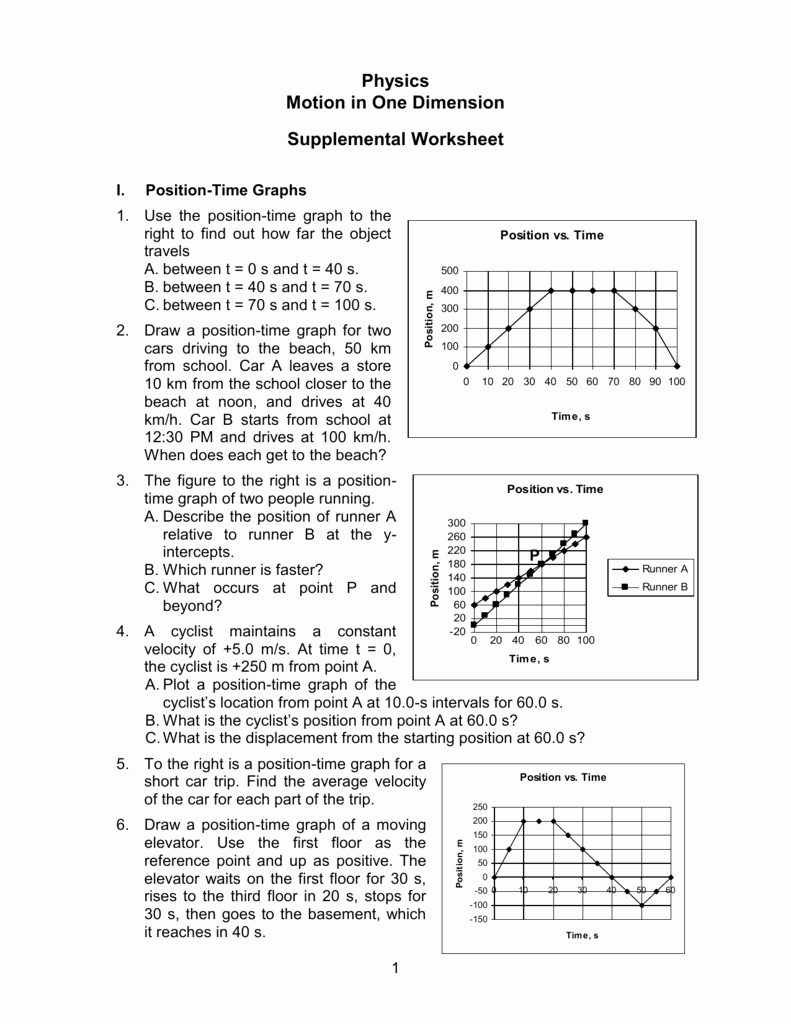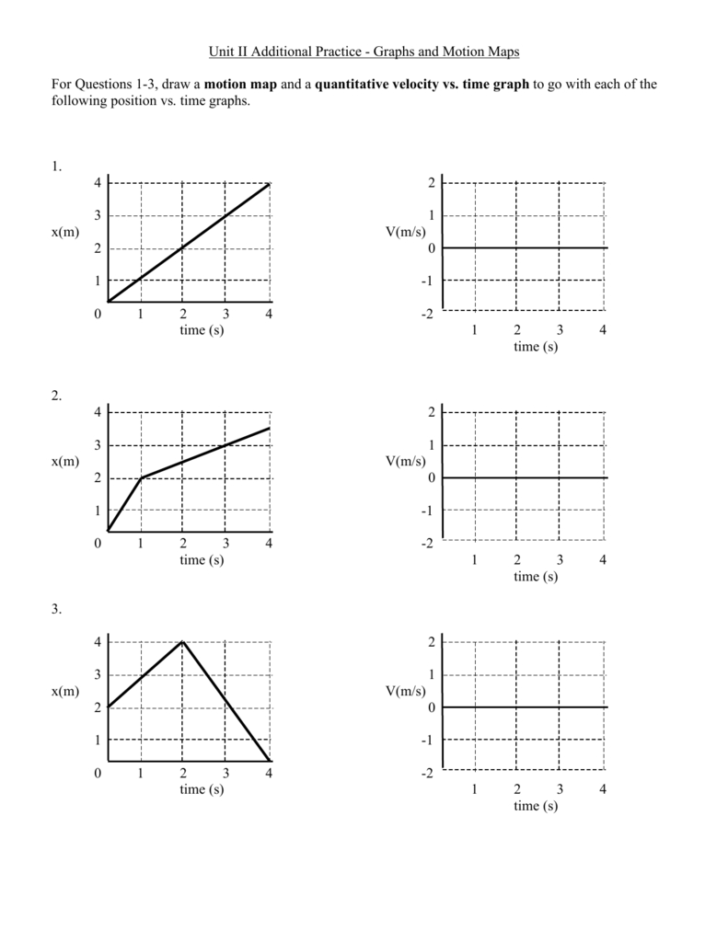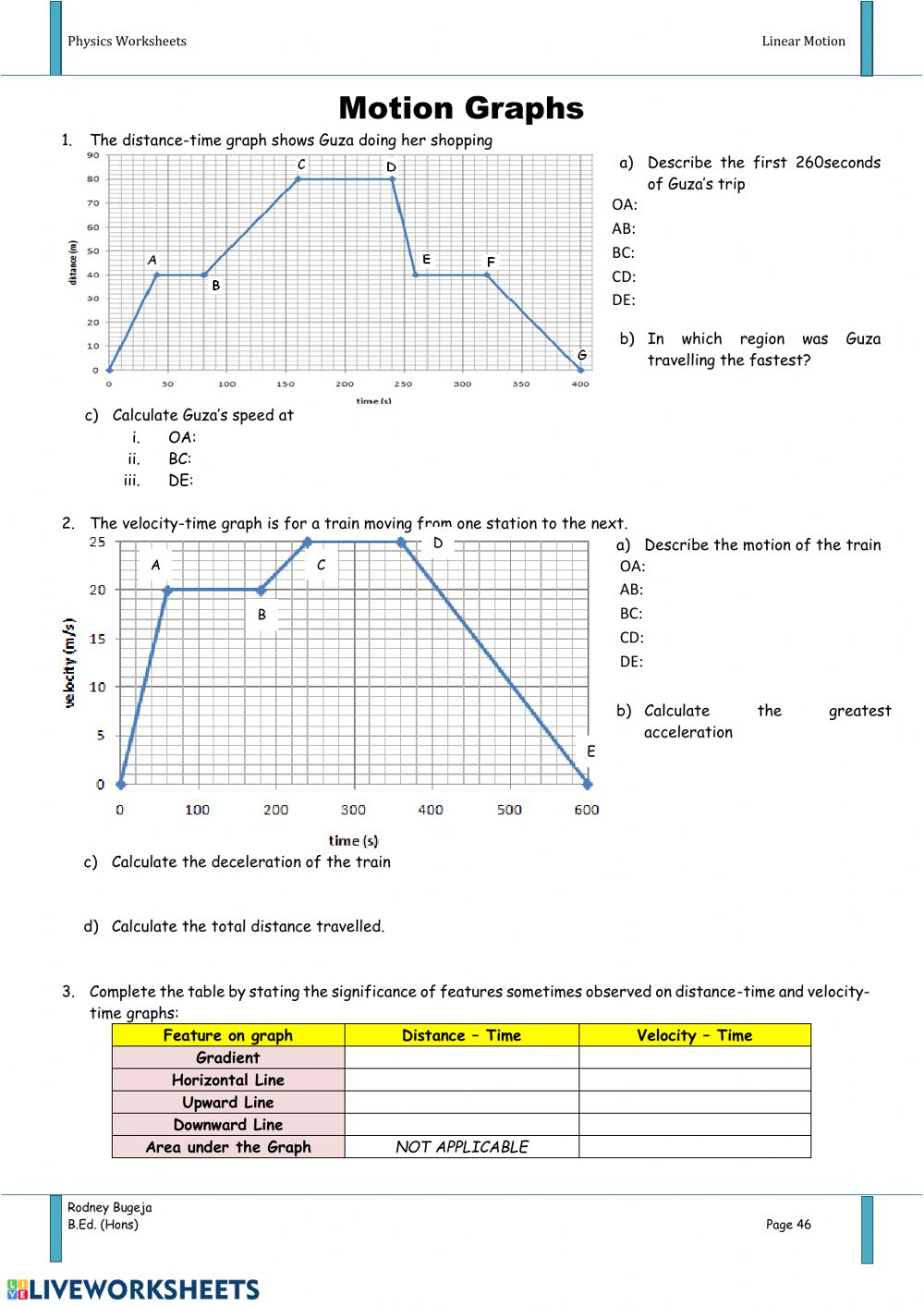Motion Graphs Worksheet - Interpreting motion graphs page 1 of 2 © 2008 by g. The graph shown above is created by an object that starts at rest from the origin. A) draw the velocity vs. An object’s motion is described by the following graph of position vs. Test your understanding of graphs of motion with four practice problems and solutions. Tick ( ) true or false for each. Motion graphs worksheet addvancemaths.com/guides fill in the gaps in these formulas: Learn how to sketch and interpret displacement, velocity, and. Time graph for an object whose motion produced the position vs time graph shown below at left. What is the average acceleration of the moving object?
Time graph for an object whose motion produced the position vs time graph shown below at left. Test your understanding of graphs of motion with four practice problems and solutions. A) draw the velocity vs. Interpreting motion graphs page 1 of 2 © 2008 by g. An object’s motion is described by the following graph of position vs. Learn how to sketch and interpret displacement, velocity, and. Motion graphs worksheet addvancemaths.com/guides fill in the gaps in these formulas: The graph shown above is created by an object that starts at rest from the origin. What is the average acceleration of the moving object? Tick ( ) true or false for each.
The graph shown above is created by an object that starts at rest from the origin. Test your understanding of graphs of motion with four practice problems and solutions. What is the average acceleration of the moving object? Interpreting motion graphs page 1 of 2 © 2008 by g. An object’s motion is described by the following graph of position vs. Time graph for an object whose motion produced the position vs time graph shown below at left. Learn how to sketch and interpret displacement, velocity, and. A) draw the velocity vs. Tick ( ) true or false for each. Motion graphs worksheet addvancemaths.com/guides fill in the gaps in these formulas:
Interpreting Motion Graphs Assessment for 9th 12th Grade
An object’s motion is described by the following graph of position vs. A) draw the velocity vs. Motion graphs worksheet addvancemaths.com/guides fill in the gaps in these formulas: Time graph for an object whose motion produced the position vs time graph shown below at left. Interpreting motion graphs page 1 of 2 © 2008 by g.
Motion Graphs And Kinematics Worksheet Motion Graphs Kinemat
A) draw the velocity vs. The graph shown above is created by an object that starts at rest from the origin. Time graph for an object whose motion produced the position vs time graph shown below at left. An object’s motion is described by the following graph of position vs. Test your understanding of graphs of motion with four practice.
Motion Graphs Physics Worksheet
The graph shown above is created by an object that starts at rest from the origin. Tick ( ) true or false for each. Time graph for an object whose motion produced the position vs time graph shown below at left. Interpreting motion graphs page 1 of 2 © 2008 by g. A) draw the velocity vs.
Motion Graph Analysis Worksheet —
Interpreting motion graphs page 1 of 2 © 2008 by g. Tick ( ) true or false for each. The graph shown above is created by an object that starts at rest from the origin. What is the average acceleration of the moving object? Test your understanding of graphs of motion with four practice problems and solutions.
Motion Graphs Practice Worksheet
Motion graphs worksheet addvancemaths.com/guides fill in the gaps in these formulas: Interpreting motion graphs page 1 of 2 © 2008 by g. Learn how to sketch and interpret displacement, velocity, and. Tick ( ) true or false for each. An object’s motion is described by the following graph of position vs.
Motion Graphs (Distance Time Graphs) Worksheet Printable and
Tick ( ) true or false for each. What is the average acceleration of the moving object? Test your understanding of graphs of motion with four practice problems and solutions. A) draw the velocity vs. Motion graphs worksheet addvancemaths.com/guides fill in the gaps in these formulas:
Interpreting Motion Graphs Worksheets Library
What is the average acceleration of the moving object? Test your understanding of graphs of motion with four practice problems and solutions. A) draw the velocity vs. Learn how to sketch and interpret displacement, velocity, and. Interpreting motion graphs page 1 of 2 © 2008 by g.
Motion Graphs And Kinematics Worksheet Motion Graphs Kinemat
Test your understanding of graphs of motion with four practice problems and solutions. Motion graphs worksheet addvancemaths.com/guides fill in the gaps in these formulas: Time graph for an object whose motion produced the position vs time graph shown below at left. A) draw the velocity vs. Interpreting motion graphs page 1 of 2 © 2008 by g.
Motion Graph Analysis Worksheet Pro Worksheet
Learn how to sketch and interpret displacement, velocity, and. The graph shown above is created by an object that starts at rest from the origin. A) draw the velocity vs. Time graph for an object whose motion produced the position vs time graph shown below at left. What is the average acceleration of the moving object?
Worksheet Motion Graphs Answers
An object’s motion is described by the following graph of position vs. What is the average acceleration of the moving object? Interpreting motion graphs page 1 of 2 © 2008 by g. Learn how to sketch and interpret displacement, velocity, and. Tick ( ) true or false for each.
The Graph Shown Above Is Created By An Object That Starts At Rest From The Origin.
Test your understanding of graphs of motion with four practice problems and solutions. Learn how to sketch and interpret displacement, velocity, and. Time graph for an object whose motion produced the position vs time graph shown below at left. A) draw the velocity vs.
Tick ( ) True Or False For Each.
Interpreting motion graphs page 1 of 2 © 2008 by g. Motion graphs worksheet addvancemaths.com/guides fill in the gaps in these formulas: What is the average acceleration of the moving object? An object’s motion is described by the following graph of position vs.









